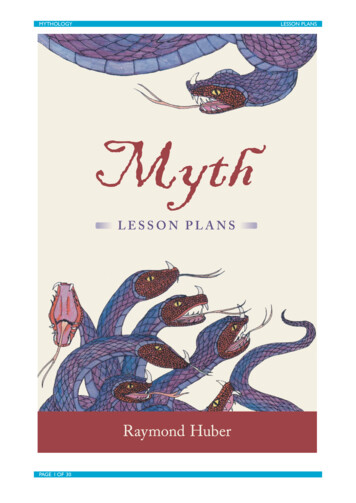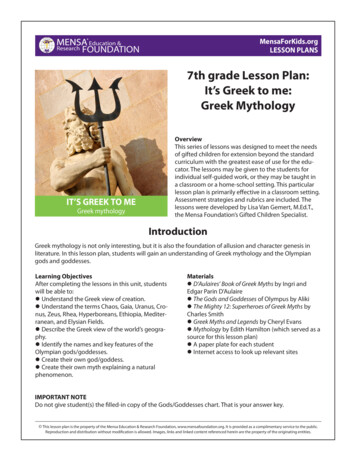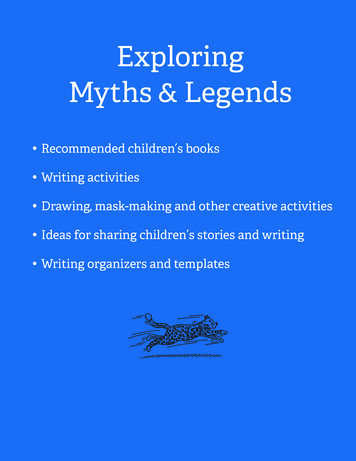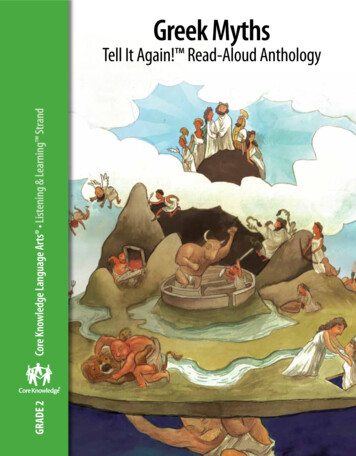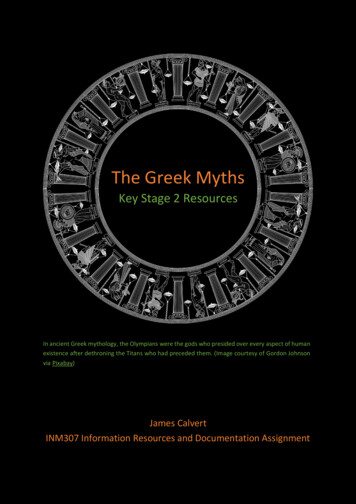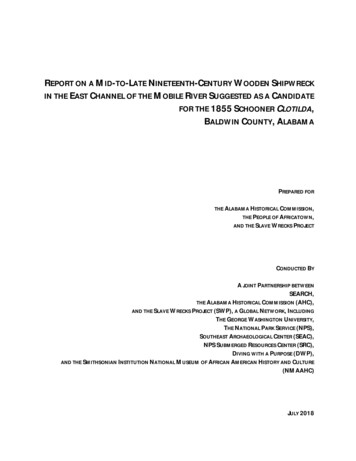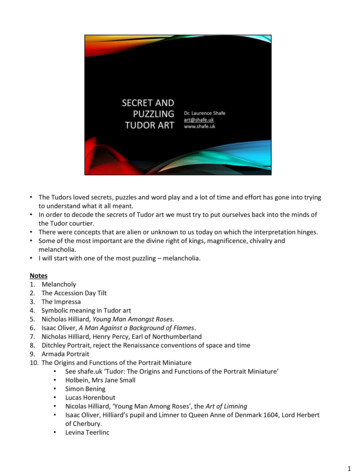
Transcription
The Tudors loved secrets, puzzles and word play and a lot of time and effort has gone into tryingto understand what it all meant. In order to decode the secrets of Tudor art we must try to put ourselves back into the minds ofthe Tudor courtier. There were concepts that are alien or unknown to us today on which the interpretation hinges. Some of the most important are the divine right of kings, magnificence, chivalry andmelancholia. I will start with one of the most puzzling – melancholia.Notes1. Melancholy2. The Accession Day Tilt3. The Impressa4. Symbolic meaning in Tudor art5. Nicholas Hilliard, Young Man Amongst Roses.6. Isaac Oliver, A Man Against a Background of Flames.7. Nicholas Hilliard, Henry Percy, Earl of Northumberland8. Ditchley Portrait, reject the Renaissance conventions of space and time9. Armada Portrait10. The Origins and Functions of the Portrait Miniature See shafe.uk ‘Tudor: The Origins and Functions of the Portrait Miniature’ Holbein, Mrs Jane Small Simon Bening Lucas Horenbout Nicolas Hilliard, ‘Young Man Among Roses’, the Art of Limning Isaac Oliver, Hilliard’s pupil and Limner to Queen Anne of Denmark 1604, Lord Herbertof Cherbury. Levina Teerlinc1
Nicholas Hilliard (1547–1619), Portrait of Henry Percy, Ninth Earl of Northumberland, c. 1594-1595,miniature on parchment, 25.7 x 17.3 cm (slightly small than A4), Rijksmuseum, AmsterdamSecret Knowledge In order to explain what I mean by ‘secret knowledge’ I have selected one Elizabethan miniatureand will spend some time analysing its many levels of meaning. It is perhaps the most cryptic ofall Elizabethan images. It was commissioned by Henry Percy, the ‘Wizard Earl’, 9th Earl of Northumberland, a wellknown Elizabethan intellectual, towards the end of the Elizabethan period in 1894 or 5. Hislibrary was the largest in England and he used a telescope to map the moon months beforeGalileo. He may have been the first person to observe sunspots. It is unusual as it is not a homage to Elizabeth except that he is dressed in Elizabeth’s colours—black and white. More significant is that black is the colour of melancholy and adopting theattitude of melancholy was a fashion of the period. It is unusual as the melancholic wasassociated with untamed, wild nature but here he is within a cultivated garden. This may be tosignify that melancholic genius can be associated with rational thought and the measurementand control of nature.What is Melancholy? I need to explain more about the nature of melancholy to understand the significance of this.The ancient Greeks reduced personalities to four types melancholic (despondent), sanguine(cheerful), choleric (emotional) and phlegmatic (unemotional) and these were associated withfour humours or fluids of the body, black bile, blood, yellow bile and phlegm, with the fourelements, earth air, fire and water, and four planets, Saturn, Jupiter, Mars and the Moon, and aperson with an excess of the humour was associated with a type of personality. So a melancholichad excess black bile and was associated with the element earth and the planet Saturn. It was Aristotle who first linked the melancholic with genius when he wrote ‘Why is it that allmen who are outstanding in philosophy, poetry or the arts are melancholic?’ The melancholicwas also associated with an interest in mathematics, measuring, numbering, counting andacquiring assets. Later writers distinguished between someone who was a melancholic becauseof an excess of black bile and genial melancholy that was associated with genius. If taken too farhowever, melancholy could lead to madness.2
The Meaning This picture is an impresa. An impresa is a picture containing symbols and a word or shortphrase that signify some conceit and propose some general instruction or message toeveryone. It should not be too obscure or too simple to work out. In the picture there is an inconsistency in the perspective and the hedge walls do notmake sense. Hanging on a branch of the nearest tree in the inner right hedge is a pair ofscales. Suspended from the left arm is a globe or a cannon ball balanced by a feather onthe longer right arm. Near the feather is the word ― ‘TANTI’. It has been suggested that the balance in the tree is a visual pun in which the words‘sphere‘ (O.F. espere) and ‘feather‘ (penne) are pun‘s on the words ‘hope‘ (espoir) and‘affliction‘ or ‘pain‘ (peine). The pun is made by Rabelais (1494-1553) and links toNorthumberland‘s family motto ‘Esperance en Dieu‘ (Hope in God) written round acrescent moon (perhaps signified by the sphere). Also note that green is the colour ofhope. The globe balanced by the feather also links to Archimedes‘s famous dictum ‘give me aplace to stand on and I will move the earth.‘ Archimedes was explaining the principles ofthe lever and it can be seen in the picture that the fulcrum point is much nearer thesphere. Note that Galileo had recently discovered the work of Archimedes and in 1586 hewrote a treatise called ‘The Little Balance‘. The word ‘tanti‘ is difficult to interpret. In Latin it means ‘so much‘ referring to a triflingamount and in Italian the ‘pene‘ (feathers) are ‘tanti‘ in the sense of ‘so many‘, numerousand excessive.’ It could be that ‘tanti‘ simply means ‘worth so much‘ or ‘this much Iweigh‘. There is also a political interpretation. The affliction could be the beheading of both hisuncle and great uncle signified by the ‘beheaded‘ branch on the left. This is balanced byhope and between the sphere and the feather there are two trees referring to the twogenerations of ancestors dishonoured. The impresa could therefore refer to the family‘sprecarious balance between hope and affliction or it could demonstrate his learningthrough its reference to a theorem of Archimedes.Notes In William Shakespeare‘s Love Labour‘s Lost (1594) a ‘School of Night‘ is mentioned whichis thought to refer to a group that met at Syon House that included Christopher Marlowe,John Dee and Walter Raleigh. The School of Night combined esoteric and scientific studies,with hermetic and cabalistic studies. Henry Percy, 9th Earl of Northumberland’s southernestates were Petworth and Syon House. The secret knowledge studied by Elizabethanscholars included magic, occultism, numerology, alchemy, astrology, Cabbala and NeoPlatonism. What we call science today was only gradually becoming distinct from theseareas of knowledge and the distinguishing attribute was that science is based onobservation and measurement of the world rather than interpretation of texts. The painting may relate to a poem dedicated to Percy that associates secret knowledgewith ‘pleasant fieldes‘ that are ‘unaccessible‘ (on a mountain top as here) where ‘divinescience and Phylosophie‘ may be contemplated, as shown in this painting. The garden contains a square with a square which was associated with an architectural2
design called the ad quadratum system that was used by the Romans and for HamptonCourt and Shakespeare’s Globe theatre. It is based on various forms of interlockingsquares particularly where one square is set diagonally inside another square. Thediagonal of a unit square is the square root of two which the ancient Greeks knew is anirrational number, that is it cannot be written as a fraction. If we consider the design of the trees we see the tree with the ‘beheaded‘ branch is theseventh tree, perhaps referring to the Seventh Earl who was beheaded. Opposite is thefeather (‘peine‘) and its pun ‘pena‘ are words for ‘sorrow‘ and ‘affliction‘ and for ‘legalpenalty‘. In this way Northumberland is saying the beheading was the correct legal penaltybut it has left his family balanced between hope and despair. The figure of Northumberland on the ground could also be a subtle symbol according toPeacock. The book near the head referring to the intellectual effort associated withscience and mechanics while the gloves at the other end of his body and near his handsignify the manual labour of scientific experiment and so the complete symbol signifiesthe balance between theory and practice in all science. The debate about whether thescience of mechanics was an intellectual or manual activity was much debated in thesixteenth century as Aristotle had said the intellectual arts are nobler than the manualarts. The artist Hilliard was also associated with passing on secret messages through hisminiatures and he may have worked with Percy to create this set of messages.Unfortunately, all of this is speculation as we do not have the key. What we do know isthat secret messages and secret knowledge was very important to the Elizabethans.Patronage This is arguably the most cryptic Tudor cabinet miniature. It is likely that is wascommissioned by Henry Percy the Ninth Earl of Northumberland (1564-1632), a wellknown Elizabethan intellectual and cultural figure. He was known as the ‘Wizard Earl‘because of his scientific and alchemical experiments and his large library. In 1594 HenryPercy married Dorothy Devereux sister of Robert Devereux, Second Earl of Essex. His southern estates were Petworth and Syon House, the latter he acquired through hismarriage to Dorothy Devereux. He was a non-Catholic but argued for Catholic tolerationand tried to negotiate with James VI of Scotland to reduce Catholic persecution when hebecame king of England. This did not happen and Henry‘s second cousin and agentThomas Percy became one of the five conspirators in the Gunpowder Plot of 1605. As aresult Henry Percy suspected of complicity and spent the next 17 years in the Tower ofLondon and was financially ruined by a fine of 30,000.Date The most likely date for the painting is between 1593 and 1595, probably 1594-5.According to Roy Strong the style appears to be influenced by Oliver which suggests a datelater than 1593. In 1593 Henry Percy became Knight of the Garter but there is no Knight‘sinsignia in the painting suggesting an earlier date. However, two other paintings ofCumberland and Essex do not show their Knights insignia so it appears that this wasacceptable.Description The programme for the miniature would have been specified by the Earl to show him as a2
student of ‘deep philosophical and mathematical studies but imbued with Renaissanceoccultism and hermeticism.‘ It is also unusual because the conventional representation of a melancholic man such asOliver‘s painting of Edward Herbert shows the melancholic in an uncultivated greenwood,beneath a tree and often beside a brook. Hilliard shows (or rather Henry Percy specified) amelancholic within a cultivated garden. This raises complex issues about whether the deepthought of the melancholic genius is a return to untamed nature (explored in theeighteenth century by Jean Jacques Rousseau) or associated with the construction ofrational thought and the taming of nature. Here we have a melancholic genius associatedwith rational thought and the measurement and control of nature as indicated by theimpresa and the cultivated garden. Roy Strong suggests the rectangular hedge is meant tobe square and is a reference to the mathematical arts and one of the ‘four guides toreligion‘ of which the others are Love, Art and Magic. The painting of Henry Percy does not appear to link to Elizabeth although one of herrepresentations as Astraea, the just virgin of the golden age, was associated with Saturnand Saturn is associated with melancholia. The elements of the painting would have been specified by Henry Percy and include: Henry Percy, shown reclining in the pose of a melancholic man with a discardedbook, hat and gloves. He is dressed in black and white and his shirt is in disarray. A cultivated garden on the top of a hill or mountain. The garden consists of arectangular or square of trees and clipped hedges within a rectangular or squareouter clipped hedge. An analysis based on conventional rules of perspectivesuggest an inner hedge parallel to an outer hedge with a vanishing point in the skyabove the top of the picture. This makes the garden look as though it is tilted upor we are looking down on it from a great height. If we are looking down then thebackground is inconsistent, in fact there is no consistent interpretation based onthe rules of perspective. This uncertainty is increased by the base of the far outerhedge becoming the inner wall of the right outer hedge and then the top of thenear outer hedge. Henry Percy‘s toe rests on the top of the near outer hedgecausing difficulties regarding the interpretation of its height. Alternatively thislight brown area can be regarded as a path. The single tree in the nearest hedgehas a sawn branch and there are four trees in the receding hedge and two treesbeyond the far outer hedge.Impresa William Camden defines in Remaines (pp. 366-7) an impresa as: An Impress (as the Italians call it) is a device in Picture with his Motto or Word,borne by Noble and Learned Personages, to notify some particular conceit of theirown, as Emblems. . . do propound some general instruction to all. . . . There isrequired in an Impress . . . a correspondency of the picture, which is as the body;and the Motto, which as the soul giveth it life. That is the body must be of fairrepresentation, and the word in some different language, witty, short andanswerable thereunto; neither too obscure, nor too plain, and most commendedwhen it is an Hemistich [a half line of verse], or parcel of a verse. The balance in the tree is a type of impresa although John Peacock suggests it is a visual2
pun in which the words ‘sphere‘ (O.F. espere) and ‘feather‘ (penne) are pun‘s on thewords ‘hope‘ (espoir) and ‘affliction‘ or ‘pain‘ (peine). The pun is made by Rabelais (14941553) and links to Northumberland‘s family motto ‘Esperance en Dieu‘ (Hope in God)written round a crescent moon (perhaps signified by the sphere). Also note that green isthe colour of hope.The globe balanced by the feather also links to Archimedes‘s famous dictum ‘give me aplace to stand on and I will move the earth.‘ This statement is meant to have been madeto King Hiero and was based on his work on levers in which he concludes ― “Proposition3: Unequal weights will balance at unequal distances, the greater weight being at thelesser distance” and “Proposition 6: Commensurable magnitudes balance at distancesreciprocally proportional to the magnitudes.”Archimedes texts had been translated in 1269 by Moerbeke including a translation of Decanonio concerning the problems of the steelyard or Roman balance (i.e. the balance ofunequal arm lengths).The word ‘tanti‘ is difficult to interpret. It is either Latin or Italian with opposite meaningsand is the plural form. In Latin it means ‘so much‘ referring to a trifling amount which issuggested by its scornful use in Marlowe‘s Edward II (Northumberland was a friend ofMarlowe). In Italian the ‘pene‘ (feathers) are ‘tanti‘ in the sense of ‘so many‘, numerousand excessive.’ Constance Kuriyama suggests ‘tanti‘ simply means ‘worth so much‘ or ‘thismuch I weigh‘.Peacock suggests the affliction is the beheading of both his uncle and great uncle signifiedby the ‘beheaded‘ branch on the left. This is balanced by hope and between the sphereand the feather there are two trees referring to the two generations of ancestorsdishonoured. Because two is not many there could even be a suggestion that his father‘sdeath in the Tower was a government murder rather than a suicide. The impresa couldtherefore refer to the family‘s precarious balance between hope and affliction or it coulddemonstrate his learning through its reference to a theorem of Archimedes. Note thatbetween 1583 and 1589 Galileo discovered Archimedes and in 1586 he wrote a treatisecalled ‘The Little Balance‘.“Secret Knowledge” Shakespeare‘s Love Labour‘s Lost (1594) mentions a ‘School of Night‘that met at SyonHouse and included Christopher Marlowe, John Dee and Walter Raleigh. The School ofNight combined esoteric and scientific studies, with hermetic and cabalistic studies.Hermeticism is ancient knowledge based on the writings of Hermes Trismegistus andthought to pre-date Plato and be based on ancient Egyptian texts. It includes alchemy,astrology and magic and its own religious beliefs in creation, reincarnation and morality. Itis related to Rosicrucianism. The Cabala (Kabbala or Qabalah) is based on interpretationsof the Hebrew Bible and classical Jewish texts and became popular following the writingsof Rabbi Isaac Luria (1534-1572). The secret knowledge studied by Elizabethan scholars included magic, occultism,numerology, alchemy, astrology, Cabbala and Neo-Platonism. What we call science todaywas only gradually becoming distinct from these areas of knowledge and thedistinguishing attribute was that science is based on observation and measurement of theworld rather than interpretation of texts.2
Maybe a clue to the painting is provided in George Peele‘s poem the Honour of the Garter,dedicated to Northumberland and including the lines:Through uncouth ways and unaccessible,Doost pass into the spacious pleasant fieldesOf divine science and Phylosophie. This describes ‘pleasant fieldes‘ that are ‘unaccessible‘ (on a mountain top) where ‘divinescience and Phylosophie‘ may be contemplated. The secret garden contains a rectangular tended inner sanctum that could be intended tobe square as the square represents wisdom. In fact it would then be a square within asquare which may refer to the technique of ad quadratum design based on a doublesquare. This is described by Jonathan Foyle in the design of Hampton Court and it appearslikely that Shakespeare‘s Globe was based on an ad quadratum system of interrelatedsquares when it was reassembled from the Burbage‘s Theatre in 1599. The symbolism of squares also included the idea of stability and as the square is ‘firm andconstant‘ so a ‘constant minded man, even equal and direct on all sides.‘ The tree trunks in the painting could relate to the straight tree as a symbol of constancy.However, this is not a lovesick man in Arcadia contemplating Elizabeth so the constancymay be the constancy of the contemplative life. If we consider the design of the trees we see the tree with the ‘beheaded‘ branch is theseventh tree, perhaps referring to the Seventh Earl who was beheaded. Opposite is thefeather (‘peine‘) and its pun ‘pena‘ are words for ‘sorrow‘ and ‘affliction‘ and for ‘legalpenalty‘. In this way Northumberland is saying the beheading was the correct legal penaltybut it has left his family balanced between hope and despair. The figure of Northumberland on the ground could also be a subtle symbol according toPeacock. The book near the head referring to the intellectual effort associated withscience and mechanics while the gloves at the other end of his body and near his handsignify the manual labour of scientific experiment and so the complete symbol signifiesthe balance between theory and practice in all science. The debate about whether thescience of mechanics was an intellectual or manual activity was much debated in thesixteenth century as Aristotle had said the intellectual arts are nobler than the manualarts.Conclusion The programme for the painting would have been constructed by Northumberlandpossibly in discussion with Hilliard because of his experience in the French Court.Northumberland was one of the scholars of the period and cryptic messages were lovedby the Elizabethans so many level of meaning would have been expected. We have seen the secret garden on a mountain top contains reference toNorthumberland‘s learning, his melancholic pose and his knowledge of many classicalsources both theoretically and practically. The combination of the theoretic and thepractical references a new approach to learning that is the beginning of what weunderstand as science. Northumberland also possible includes references to his dishonoured family and how thishas left him balanced between hope for the future and despair. We know that the balancetilted to despair as he spent years in the Tower (1605-1621) because of his cousin involved2
in the Gunpowder Plot and Northumberland ironically died on 5th November 1632. ‘Hilliard‘s miniatures were often linked with spy missions Hilliard‘s miniatureswere considered somehow appropriate for this kind of undercoverwork Sidney‘s sonnet devices and Hilliard‘s limning devices are in a waythemselves ―”ciphers” Both poet and limner in developing an artifice of secrecywere ―”On Her Majesty‘s Secret Service.”‘ Unfortunately, we have lost the key and are left with tantalizing glimpses of hiddenmeanings.Provenance 9th Earl of Northumberland; to his son Algernon, 10th Earl (1602-68); to his son Joceline,11th Earl (1644-70); to his only child Elizabeth who married Charles Seymour, 6th Duke ofSomerset (the ‘Proud Duke‘) documented by George Vertue in 1728, to Charlottedaughter of his second wife Charlotte who married Heneage, 3rd Earl of Aylesford in1750, then it descended in the family of the Earls of Aylesford until sold by Christie's,London, 23-VII-1937, no. 45 to Dr. N. Becvh, Amsterdam, then sold by Fred. Muller, 9-IV1940, no. 66, as a portrait of Sir Philip Sidney, to Dr. M.E. Kronenberg, Rotterdam. TheRijksmuseum bought the miniature in 1981; its catalogue number is RP-T-1981-2.BibliographyAdams, J., How Large Was the Globe Playhouse? Shakespeare Quarterly, Vol. 33, No. 1,(Spring, 1982), pp. 93-94Clagett, M., The Impact of Archimedes on Medieval Science, Isis, Vol. 50, No. 4, Dec., 1959Cummings, F., Boothby, Rousseau and the Romantic Malady, The Burlington Magazine, Vol.110, No. 789 (Dec., 1968), pp. 659-667Downs, R., Books that Changed the World (New York: Signet Classic, 2004)Fumerton, P., "Secret" Arts: Elizabethan Miniatures and Sonnets, Representations, No. 15(Summer, 1986), pp. 57-97Kuriyama, C., Christopher Marlowe: A Renaissance Life (Cornell, Cornell University Press,2002)Machamer, P., The Cambridge Companion to Galileo (Cambridge: Cambridge University Press,1998)Peacock, J., The ‘Wizard Earl‘ Portrayed by Hilliard and Van Dyck, Art History, Vol. 8, No. 2,June 1985, pp. 139-157Sarafianos, A., The Many Colours of Black Bile: The Melancholies of Knowing and Feeling,Papers on Surrealism, Issue 4, (Winter, 2005)Strong, R., The English Renaissance Miniature, (London: Thames and Hudson, 1983), pp. 108109Strong, R., Nicholas Hilliard‘s miniature of the ‘Wizard Earl‘, Bulletin van het Rijksmuseum,Vol. 31(1983), No. 1, pages 54-62Strong, R., The Leicester House Miniatures: Robert Sidney, 1st Earl of Leicester and His Circle,The Burlington Magazine, Vol. 127, No. 991 (Oct., 1985), pp. 694 696-701 703Strong, R., The Cult of Elizabeth: Elizabethan Portraiture and Pageantry (London: Pimlico,1999), particularly Chapter II, The Courtier: Hilliard‘s Young Man amongst RosesStrong, R., Gloriana: The Portraits of Queen Elizabeth I (London: Pimlico, 2003)2
Trattner, W., God and Expansion in Elizabethan England: John Dee, 1527-1583, Journal of theHistory of Ideas, Vol. 25, No. 1 (Jan., 1964), pp. 17-34Wells, R., John Downland and Elizabethan Melancholy, Early Music, Vol. 13, No. 4 (Nov.,1985), pp. 514-528Yates, F., Chapman and Durer on Inspired Melancholy, University of Rochester LibraryBulletin, Vol. XXXIV, 1981, pp. 1-112
Albrecht Dürer (1471–1528), Melencolia I, 1514, engraving, 18.6 23.8 cm This work has been subject to many interpretations, possibly more than any other engraving. The “I” in “Melencolia I” most likely refers to the first type of melancholia defined by Germanhumanist writer Cornelius Agrippa which is one in which the imagination of the artistpredominates over reason. The picture contains the following elements: The magic square contains the date ‘1514’ in the bottom row and the rows, columns andfour quadrants add up to ‘34’. The truncated rhombohedron with a faint human skull on it. A rhombus is a four sidedfigure with sides of equal length and a rhombohedron consists of six rhombuses. In thiscase the top and bottom corners have been sliced off and the figure has become knownas Dürer’s solid. The female figure represents genius and she is shown surrounded by the tools ofgeometry and architecture. The hourglass shows time running out. The scales are empty. In the sky there is what might by a comet and a rainbow and the sign ‘Melancolia I’carried by a bat. Mathematical knowledge is referenced by the use of the symbols: compass, geometricalsolid, magic square, scale, hourglass The most famous interpretation is by the art historian Erwin Panofsky. He remarks that itsinfluence extended all over Europe for three centuries and all representations of melancholyowe a debt to Dürer. Others have said it is the ‘most written-about image in the history of art’(Guilia Bartrum). Melancholia was a Latin translation of the Greek word meaning black bile and it was seen as animbalance in the humours, in particular an excess of black bile. Aristotle though melancholia wasa condition of ‘greatness’ and all great poets, statesmen and philosophers were melancholic.Marsilio Ficino (1433-1499) writing in the fifteenth century reinforced the idea of ‘divinemelancholia’ and ‘melancholic genius’. Ficino revived Neoplatonism and was the most influential3
humanist of the early Italian Renaissance. He distanced melancholia from insanity andassociated it with genius and greatness. Saturn, god of the earth and of melancholia, wasassociated with works on the earth in wood and stone.Melancholia The best known melancholic of this period is Shakespeare‘s Hamlet whose contemplationof alternative possible paths of action leads to madness and inaction. Melancholia derives from the classical belief that our state of health is derived from themix of four humours, black bile, yellow bile, phlegm and blood. An excess of any one gaverise to a particular temperament. An excess of black bile made the person melancholic(despondent, quiet, analytical, serious), yellow bile choleric (ambitious, restless, easilyangered), phlegm phlegmatic (calm, thoughtful, patient, peaceful) and blood sanguine(courageous, hopeful, playful, carefree). The ancient Greeks associated the four humours with the four elements and four planetsand a person with an excess of the humour was associated with a type of personality. In190AD Galen associated these types with four temperaments. ElementEarthAirFireWater HumourBlack bileBloodYellow bilePhlegm PlanetSaturnJupiterMarsMoon PersonalityDespondent CheerfulEmotionalUnemotional TemperamentMelancholic SanguineCholericPhlegmatic Erwin Panofsky wrote Saturn and Melancholy in 1964 about the emergence ofmelancholy as an artistic temperament. An early writer on this aspect of melancholy wasMarsilio Ficino who wrote De Vita Libri Tres (1480) and De Vita Sana (On a Healthy Life).He was the first Renaissance writer to interpret melancholy positively and link it withgenius although it was Aristotle who asked ‘Why is it that all men who are outstanding inphilosophy, poetry or the arts are melancholic?‘ Aristotle concluded that for greatintellectuals it was not as a result of overheated humours but a disposition to melancholyand he cited Socrates and Plato as examples of particularly gifted sufferers. Ficino linksthis with Platonic ideas about different kinds of mania. As a result, in the Ficinian tradition,genial melancholy is distinguished from melancholy associated with black bile which is saidto cause not prodigious aptitude but madness. The melancholic was also associated withan interest in mathematics, measuring, numbering, counting and acquiring assets. There were three types of melancholy—of the imagination (artists), of the reason(philosophers) and of the spirit (theologians and saints).3
Isaac Oliver, Edward Herbert, 1st Baron Herbert of Cherbury, 1610-1617 This painting was produced during the Stuart period but is shown as a further illustration ofmelancholy. It shows that melancholy continued as a knightly virtue throughout the Tudorperiod and into the Stuart period. Edward Herbert is wearing his Accession Day costume and his tilt armour is with hissquire is in the background. The casual pose, the babbling brook, the greenwood, theuntied laces round his collar all indicate he is melancholic. There are many portraits ofcourtiers in their tilt costume so they were clearly very proud of them and they cost asmall fortune. During the later 16th and early 17th centuries, a curious cultural and literary cult ofmelancholia arose in England. In the visual arts, this fashionable intellectual melancholyoccurs frequently in portraiture of the era, with sitters posed in the form of "the lover, with hiscrossed arms and floppy hat over his eyes, and the scholar, sitting with his head resting on hishand"—descriptions drawn from the frontispiece to the 1638 edition of Robert Burton's TheAnatomy of Melancholy, which shows such stock characters. These portraits were often set outof doors where Nature provides "the most suitable background for spiritual contemplation" or ina gloomy interior.Notes Edward Herbert, 1st Baron Herbert of Cherbury (1583-1648) Painted around 1610-17. Isaac Oliver (c.1565 – 1617) was a French-born Englishminiature portrait painter. Born in Rouen, he moved to London in 1568 with hisHuguenot parents, Peter and Epiphany Oliver, to escape the Alvan religious persecutionin France4
Nicholas Hilliard (1547-1619), Portrait of George Clifford, Earl of Cumberland, c. 1590, 25.2x 17.5 cm, National Maritime Museum A knight was not just a melancholic figure, above all they were someone who followedthe chivalric code. The chivalric code was associated with a code of conduct adopted by medieval knightsbetween 1170 and 1220, about the time of Richard the Lionheart (1189-1199) and theThird Crusade (1189-1192). It was a synthesis of earlier Roman and Carolingian traditionsand a moral system combining military bravery and honour, knightly piety and courtlymanners. The chi
Nicholas Hilliard (1547-1619), Portrait of Henry Percy, Ninth Earl of Northumberland, c. 1594-1595, miniature on parchment, 25.7 x 17.3 cm (slightly small than A4), Rijksmuseum, Amsterdam Secret Knowledge In order to explain what I mean by secret knowledge I have selected one Elizabethan miniature and will spend some time analysing its many levels of meaning.

